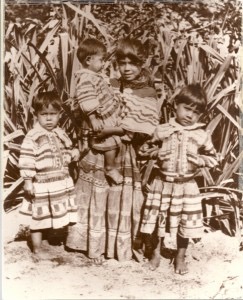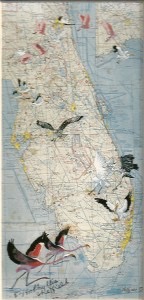Originally aired in December of 1996 on WUFT, FPR and the program 51%

At a time when there’s been so much focus on cleaning up the Florida Everglades it’s hard to think back to the period before dikes and drainage canals affected the flow of water from Lake Okeechobee through Florida’s River of Grass. Picture the 1930s, the decade when the Great Depression had its grip on most of the nation. Donna Green-Townsend reports, the 30s was also when two adventurous young women in South Florida captured forever on film, pictures of a unique culture about to disappear from Florida’s landscape.
Full Script:
Sixty years ago when Phyllis Sheffield ventured by boat with her aunt into the Florida Everglades to photograph Miccosukee Indians, little did she know she was capturing Florida history. In the 1930s, Phyllis Sheffield was just a teenager learning the ropes of photography from her mother’s sister, Florence Stiles Randall, who owned a small studio in Coconut Grove, when a young Miccosukee woman walked into the studio to sell mulberries she carried in her homemade palmetto basket. Phyllis and her aunt Flossie bought some berries and ended up photographing the young Miccosukee woman. That studio photo session led to a series of boat trips into the Everglades Phyllis says she’ll never forget.
(sound of her pouring over negatives or prints)
Pouring over negatives and rare prints from her 60 year old collection at her present home in Palatka, Phyllis, now 79 is still thrilled about her role in capturing the early Miccosukees on an old 5 by 7 box camera:
Phyllis Sheffield, “It was very exciting and we got to really like the people and we knew that they hadn’t been recorded and I think in the back of our minds we knew that it was history we were recording but we didn’t realize we were some of the few people who were doing it.”
Phyllis says she always considered herself adventurous. After all her parents “paved the way” for her back in 1914. That’s when they sold their North Dakota Farm and took a two year trek down the Missouri and Mississippi Rivers to begin a new life in Southern Florida:
Phyllis Sheffield, “They ran what was called a sea bottom boat that was the first boat in Florida to show the bottom of the coral reefs, but he always had a boat too, after the sea bottom sank. That’s another story. It sank with 200 people aboard, but anyway when he stopped that he started running a banana boat into the Bahamas so I think he was adventuresome, very. And I think some people were just born with those kinds of genes.”
No wonder it didn’t seem unusual to Phyllis Sheffield to be a woman engineering a boat into the wild Florida Everglades in the 1930s to photograph the Miccosukees:
Phyllis Sheffield, “We knew we were on an adventure but we had no fear of these Seminoles because the Miccosukee, because the ones who came in the studio were so nice and gentle so I don’t remember being frightened and we were so welcomed. But I know it was an adventure.”
Phyllis and her aunt often took along gifts for their photo subjects, everything from candy and picture books to combs and even a sewing machine. The gifts made getting smiles on camera a little easier. The challenge was toting the old camera gear to their swampy photo shoots:
Phyllis Sheffield, “It was heavy equipment, we had a great big old wooden tripod and always carried a reflector in case we wanted the light reflected some other place than it was….I never weighed it but it was a 5 by 7, a pretty big camera and it came out on a track that must have been a foot or more that you had to pull it out on, a metal track and it was a big wooden and old shiny one. It was a matter of pulling the camera out on the track and you couldn’t see on the upside down ground glass and you had to be able to see to focus it so you’d put a black cloth over your head. You must have seen the pictures of people doing that. Well that’s the way we took these photographs.”
Phyllis recalls how word spread through the tribe about the photos…and how on subsequent trips many of the Miccosukees seemed to encourage the two women to take their pictures….sometimes even striking a pose before asked:
Phyllis Sheffield, “We were coming up snapper creek and saw this girl bathing her baby on the beach on the edge of the shore and I said, oh auntie there’s a Madonna. I always ran the boat because Auntie was always timid about anything electrical or anything mechanical. So we pulled in the edge and got out of the boat and while we took the camera out and kept talking to her and she was ignoring us but we could tell she was posing bathing her baby and she kept bathing the arm and the hand and we set the camera up and kept talking to her and she kept ignoring us and it took us a good 15 or 20 minutes even gave me time to put the halo behind her head with the reflector. And as soon as we took the photograph she got up and left. I think she was just timid really, but that was the cleanest baby in the Everglades, I can tell you that.” Did you give a copy of the picture to her? “Yes and we got a big smile then.”
Phyllis titled that photograph “Madonna.” There’re photos she’s named “Friends” of two young Miccosukee girls…all smiles, and there’s “Brave Hunter” named for the young man posing with his parent’s slingshot. But some of the pictures are tough for her to talk about, even today 60 years later:
Phyllis Sheffield, “Like I say, it’s a very sad photo for me, this is practically the only one I’ve printed from it because the little baby over the man’s shoulder died shortly after that and from I think it was just measles because he had spots on him at the time…but they wanted their picture made at the time and I think one reason was because this baby was in it. It’s one of the few pictures we have of men and you can see how sober they all are so I think they knew the baby was dying.” What would you call this picture? “I haven’t given it a name because it’s sad to me.”
For nearly 60 years the historical Miccosukee photos stayed in storage in her Aunt Flossie’s home. Not until Flossie died in 1987 at the age of 96 did Phyllis remember them.
(sound of her van door and talking about the photos in the van)

Phyllis has travelled to art shows across Florida for years displaying and selling watercolor drawings on old maps and nautical charts, her bread and butter she says. She only added the Miccosukee photos to her shows in recent years. Unfortunately, because she didn’t realize the historical significance of the negatives sooner, many were lost:
Phyllis Sheffield, “And when I finally took out the negatives I’d lost about 50 with mildew and things. I didn’t have the sense to take care of them. See nobody said Phyllis you and auntie Flossie are shooting history. For heaven’s sake take care of those negatives.”
When Phyllis decided to do something about preserving the negatives, she made an offer to the Smithsonian:
Phyllis Sheffield, “I took my pictures to them a couple of years ago and they were excited about them. I took them to the Indian Museum in New York, the head of the photography department there. She submitted them to the council of the museum, the people who decide what they’re going to show and when, but I told them if I was going to give them my 5 by 7 negatives that before I was gone I wanted to see a show and wanted them to hang a show and they read in the letter that they will hang a show within two years. I said heck, I’m pushing 80 awful hard. I expect to live to be 105 but heck who knows so and they said they would if I’d give them my negatives.”
Phyllis says she hopes to see a Smithsonian show with her Miccosukee photos within the next year. There’s even been some talk from various parties about doing a book or even a calendar with the old photos.
As she nears her 80th birthday she plans to slow down on the art show circuit, but won’t sit still. A trip to Mexico is next on her agenda. She’s already travelled to China and Russia. And oh, there’s a trip planned for next summer. What else more appropriate for the adventurous Phyllis Sheffield but a trip down the Nile River. For 51% I’m, Donna Green-Townsend.